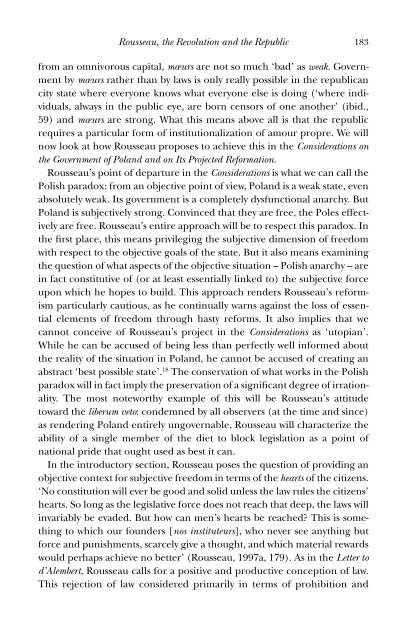Rousseau and Revolution
Rousseau and Revolution
Rousseau and Revolution
Create successful ePaper yourself
Turn your PDF publications into a flip-book with our unique Google optimized e-Paper software.
88 <strong>Rousseau</strong> <strong>and</strong> <strong>Revolution</strong><br />
The adoration surrounding <strong>Rousseau</strong> did indeed reach religious <strong>and</strong><br />
cultish dimensions, <strong>and</strong> the fact that he was arguably persecuted (or so he<br />
believed) by the men in power, be they politicians or philosophes, had, in the<br />
eyes of the revolutionaries, given him a Christ-like magnitude. Although<br />
the fi gure of <strong>Rousseau</strong> was used to replace a deposed God, the contextual<br />
structure of the Catholic faith, as Quinet argues, remained intact.<br />
<strong>Rousseau</strong>, like Christ, was glorifi ed in a covenant of persecution <strong>and</strong> suffering.<br />
By placing him on the altar, people were reminded of their own affl ictions<br />
suffered under the Ancien Régime, <strong>and</strong> the revolution was seen as<br />
both their <strong>and</strong> <strong>Rousseau</strong>’s vengeance over the oppressors. In his Lettres sur<br />
les Confessions published in 1791, Guingené, a great admirer of <strong>Rousseau</strong>,<br />
starts his preface with the following words: ‘The man of genius is avenged;<br />
The French Nation is vindicated in the eyes of Europe. It has erected a<br />
statue to the Author of the Social Contract <strong>and</strong> decreed that his Widow<br />
will be provided for at the expense of the State’ (Guingéné, 1791, v–vi).<br />
Guingéné then proceeds to compare his literary homage to <strong>Rousseau</strong> to<br />
drops of incense devotedly left at the foot of the author’s statue, ‘at a time<br />
when his memory has somehow become sacred’. The religious symbolism<br />
surrounding <strong>Rousseau</strong>’s glory is once again raised by the same Guingéné<br />
in La Feuille villageoise, a revolutionary paper founded in Paris in 1790 to<br />
spread the ideals of the revolution throughout all the villages of France. In<br />
the journal, celebrating the 1794 Fête des victoires <strong>and</strong> the particular homage<br />
given to <strong>Rousseau</strong>, Guingéné writes, ‘It seemed not like we were honoring<br />
the man of genius, the eloquent man, the great man but rather the good<br />
man, the apostle of good morals, the benefactor of humanity [ . . . ] All of<br />
this had airs of magic <strong>and</strong> religion’ (cited in Roussel, 1972, 14).<br />
As Jean Roussel notes in Jean-Jacques <strong>Rousseau</strong> en France après la Révolution,<br />
the worship of <strong>Rousseau</strong> did move from the ceremonial to the ritual. As the<br />
Jacobins gained more power, it was common to see among the populace, at<br />
least for a short period of time, a sort of sacrament to honor the author of<br />
the Social Contract. Roussel writes,<br />
Among the people <strong>and</strong> beyond, we witness a sort of mystical recourse to<br />
<strong>Rousseau</strong>, as if there was a need for a “tutelary genius”, an unlikely intercessor<br />
during a precarious time between the Frenchmen <strong>and</strong> the<br />
“Supreme Being” or Nature. The Cult of the Martyrs of Liberty had<br />
recently given to the adoration of <strong>Rousseau</strong> a dramatic character, <strong>and</strong><br />
often added his name to the sacrifi cial consecration which until then was<br />
limited to the “trinity” of Le Peletier, Marat <strong>and</strong> Chalier. (Ibid.)
















